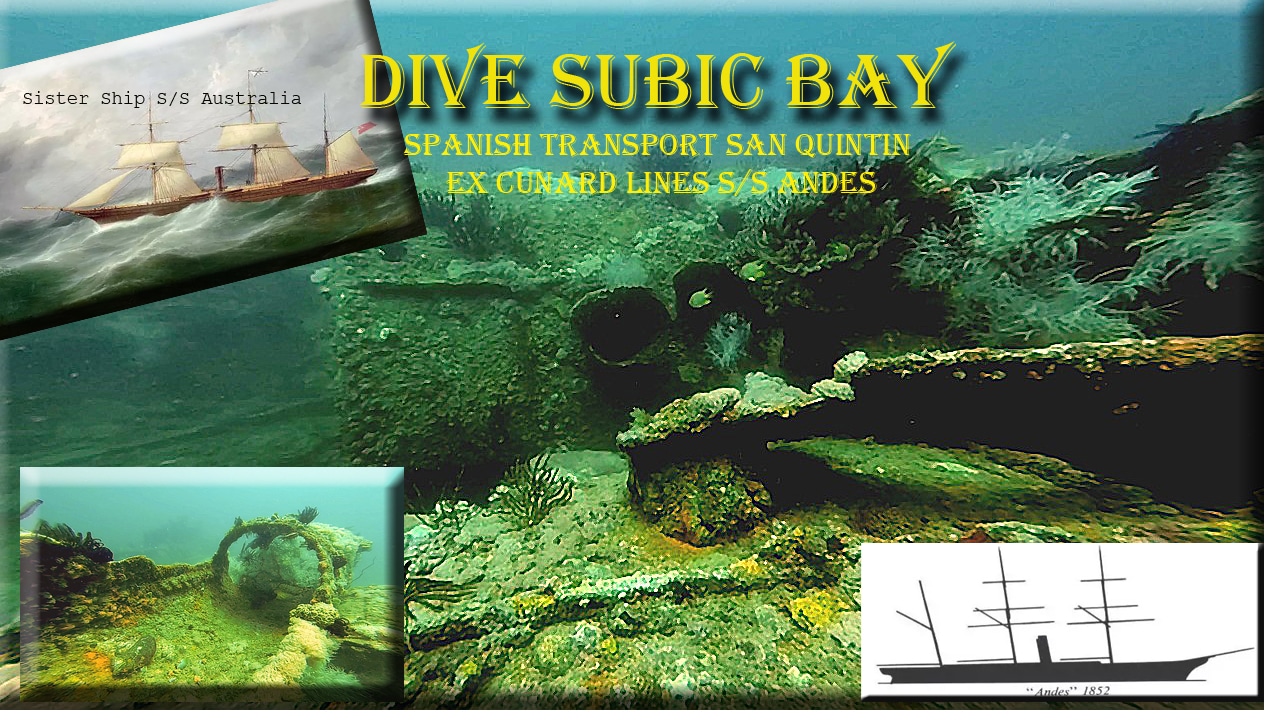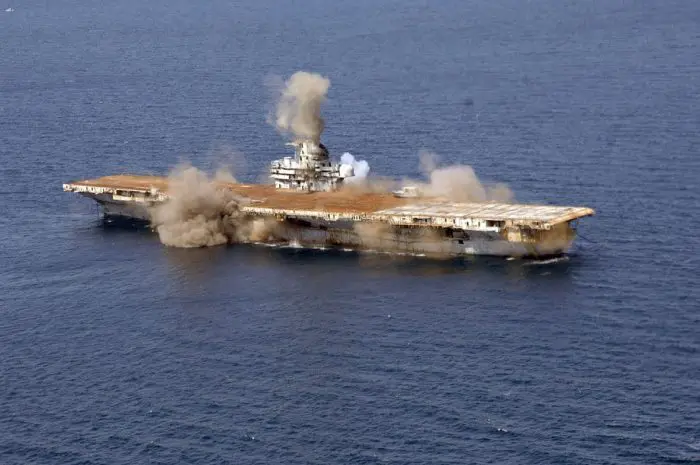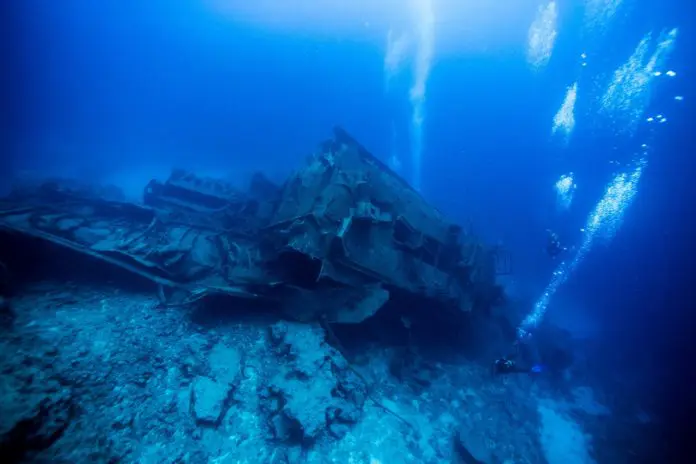The dive leader gets a confirmation from each diver, they are ready. A signal to descend is given, You raise your arm and release air from your BCD. As you start your descent, you follow the mooring line and see the reef below. As you get closer the details emerge, first a general outline of the reef, you can make out what was once the bow of a ship, closer still and you see a few sharks circling the reef. When you arrive, you see what was once the deck of a proud ship now has coral fans and is teeming with marine life. Welcome to your first shipwreck dive.
Shipwreck diving has a special draw to some divers, I am one of them, and many of the best dives in the world are on dive sites that contain a shipwreck. Some divers, just dismiss wrecks without giving them the consideration they deserve. You hear things like: “I want a real reef”. Or they think that shipwrecks are too dangerous or only for advance divers. These divers do not understand wreck diving and how important wrecks can be. The fact is, we need to evaluate each shipwreck in the same manner we evaluate any dive site and make a decision if it is within your abilities and certifications.
How Many Shipwrecks?
The UNESCO estimates that there are over three million shipwrecks in the world. Most of these are too deep for diving and will never be found, still thousands of shipwrecks have been found and in waters that can be dived. Even the recreational diver limited to a mere 40 meters, will have more choices than they can dive in a lifetime. How do these ships end up at the bottom of the sea? Many, possibly the majority, of dive sites are due to war, however, most ships are the victim of mother nature.

- Ships sunk Man against Nature: Since man has been going to sea, he has battled against it and mother nature and frequently losing. In ancient times, Ships never returning to their home port was common. The Great Lakes are considered as some of the most dangerous waters in the world. In the last 400 years, 6,000 ships have sunk killing over 30,000 people. 19 ships were destroyed including 12 that sunk and over 250 killed in a single storm in November 1913. Do not just shrug and say that in the past. Between 2004 and 2014, saw the lost of 1,271 ships. Add another 75 in 2015. More recently, The Ocean Dream, formerly the Sun Princess, sank 27 February 2016 off the coast of Thailand where she had been anchored for a year. Since then a Chinese ore carrier capsizes and sunk.
- Ships sunk Man against Man: Wars, especially WWII, has created thousands of sunken ships. Many of these are close to land often in water shallow enough for diving. Chuuk Lagoon, Coron and Palau are a few of the best known, and the Graveyard of the Atlantic has both ships sunk by war and nature. You could also include the Bikini “Nuclear fleet” in this group.
- Ships Sunk by Man to help Nature: There has been times when man has purposely sunk ships. While some of the ship dive sites in Apra Harbor, Guam are war wrecks, most where placed there to form a breakwater. More recently ships have been sunk by environmental groups, often with the dive industry assistance, as an artificial reef, a means to provide an area for marine life to flourish. The USS Oriskany now nick named the “Great Carrier Reef”, is one example. These ships, which have been cleaned and stripped of harmful material before being sunk, have a enormous positive environmental impact in areas where local reef and marine life population have been heavily damaged. They also support the local dive communities. The California Ships to Reefs (CSTR) has put a number of ships off the state’s coast. On July 14th, 2000, the HMCS Yukon slipped below the water to become Californian’s largest reef. All did not go as planned as she sank before everyone was ready, so she on her side and not upright as planned. It took 14 months, 2500 volunteers and 1.5 million dollars to clean and sink her. As a dive site she draws 11,000 divers a year, more than half divers who traveled to dive her, bringing in 6.6 million to the local economy. Florida also has an impressive ship to reef program, as does British Columbia Canada and other locations.
Wreck Diving Certification
One of the confusing points for many divers concerns Wreck Diving certification. Many divers ask do I need to be wreck certified, the answer is a definite “maybe”. It really depends on your dive plan. Penetration dives, those that go into an overhead environment, require that you be trained. The PADI Wreck Diver Course and the SSI Advance Wreck Diver Course allows divers to enter a wreck within the limits of the light zone. This means divers must be able to see the light of the entrance. To go beyond this range, a diver needs to be certified as a technical diver and have full technical diving equipment.

Many divers find the wreck courses helpful even if they do not desire going inside of a wreck. The PADI course and the SSI courses are similar. SSI separated the basic wreck diving information and penetration skills into different courses. PADI does it in one course with an alternate 4th dive for those who do not want to penetrate a wreck. The first half of the PADI course and the SSI Wreck Diver course concerns topics like research ship histories, preservation of wrecks, hazards, navigation and mapping. Many divers who dive outside of a wreck will find these topics helpful, however, these are not mandatory skills to dive a wreck site. The second portion of the PADI course and the SSI advance wreck course concerns topics and skills that are necessary to penetrate a wreck. These include laying lines, buoyancy issues, silt outs, and overhead environment hazards.
While we generally call wreck diving shipwrecks, there are hundreds of other wrecks out there as well. Aircraft are often found, even trains.
Ships are a “she’” and have a personality
Ships have traditionally been called “she”. Some in the maritime industry wish to change that and call them “it”, still the tradition continues. A number of years ago, in response to Lloyd’s taking the position that ships are “it”, the Royal Navy gave their view.
“The Royal Navy will continue to call its ships ‘she’ as we always have done. It’s historic and traditional,” A spokesman said. “Ships have a soul. If I remember my history, they are female because originally the ship was the only woman allowed at sea and was treated with deference and respect – and because they are expensive.”
Many divers will agree that a ship has a soul, and many times you will hear divers talking of that after a dive. More so on ships that were not prepared to become an artificial reef. As you dive the deck of a war ship lost in battle or a merchant that hit a reef and sank, you are seeing a time capsule of history. Reaching back to a time and place where other men lived and may have died. You can often sense her personality decades even centuries latter. You also see, how nature as embraced her and made her their own. Attracting fish large and small, providing a safe home for juvenile fish that would not of had one without her. As her paint and metal fades and becomes rusted, colorful sponges and corals gives her a new look. In time, the coral will mask the details leaving just the grace of her lines.
Many may consider her “artificial”, but there is nothing artificial about the coral, sea fans and marine life. They do not care about her past, they only care for what she has become. Should we not treat all ladies like that?

